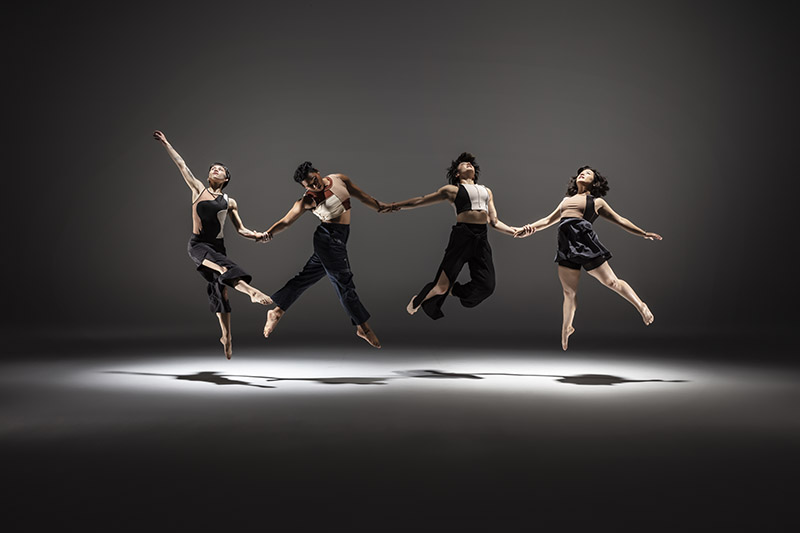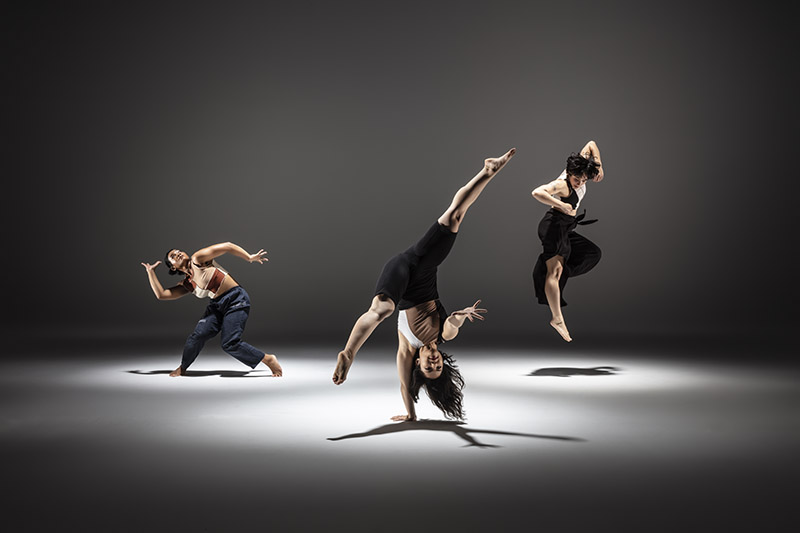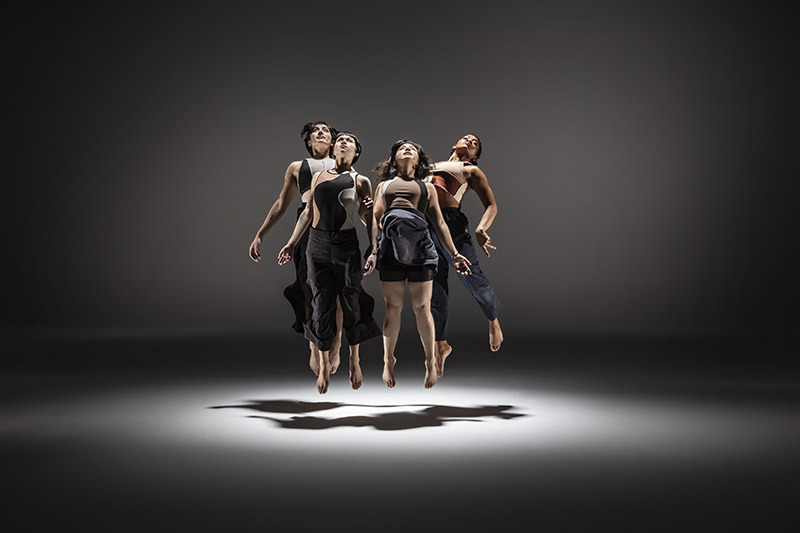Holding the Complexity of Hybridity
An Interview with Megan Lowe
BY EMMALY WIEDERHOLT
Photos by RJ Muna
Megan Lowe is the choreographer and director of Megan Lowe Dances in the Bay Area. Her upcoming dance-theater work, Gathering Pieces of Peace, explores mixed-race Asian American Pacific Islander identities and will premiere at ODC Theater in San Francisco on September 1-9. Here, Megan discusses how mixed-race identity is an experience that is nuanced and often overlooked, how she hopes to highlight and celebrate mixed-race Asian American Pacific Islander experience, and why it’s more important than ever to embrace the complexity of hybridity.

Dancers: Malia Hatico Byrne, Clarissa Dyas, Melissa Lewis Wong, and Megan Lowe
~~
Can you tell me a little about your dance history – what kinds of performance practices and in what contexts have shaped who you are today?
Dance is in every fiber of my being. It’s hard to separate myself from it. I started taking dance classes when I was three years old and started making my own dances at a really young age. I had an athletic craving for physical activity and did climbing, gymnastics, frisbee, running, and basketball, but dancing was where I felt like my most authentic self. I knew that at a young age. It led me to major in Theater, Dance and Performance Studies at UC Berkeley and then pursue a professional career.
Since graduating in 2012, I’ve had the opportunity to perform with a lot of San Francisco based companies, including Flyaway Productions, Lenora Lee Dance, Dance Brigade, Scott Wells & Dancers, Lizz Roman & Dancers, Kambara + Dancers, Epiphany Productions, and more. I feel grateful for those opportunities to grow as a dancer and performer. During that time I’ve been choreographing my own works – both live performances and film. I started presenting my own work in the Bay Area in 2013. In 2018, I got fiscal sponsorship from Dancers’ Group and officially made Megan Lowe Dances an arts organization.
Shortly after, I produced my first evening-length piece in 2019 called Action Potential that was a site-specific dance and live music adventure where performers played on an athletic playground in Emeryville. That project processed this life-threatening event where there were some people getting attacked in front of my house, and my partner and I tried to help them, and then the attacker turned on us and broke into our home. Dance helped me process that trauma.
How would you generally describe your work to someone unfamiliar with it?
My primary modes of dance practice are site-specific dance, contemporary, modern, improv, contact improv, and aerial. I love exploring the possibilities of my body in relationship to other people and structures. Throughout my life, I’ve been perceived as a small Asian female, and there are a slew of stereotypes that go along with being perceived as a small Asian female. A lot of my dance career is consciously subverting expectations around size, race, and gender by showing my strength and pushing against the boundaries of what is considered possible. The forms of dance that stimulate me the most are primarily practiced by people who aren’t of color, so in my own work I’ve been trying to make spaces that are inclusive for myself and other marginalized dancers.
My works tend to be dynamic, athletic, and virtuosic, with climbing over objects and weight sharing partnering. In addition to my dance theater productions on stages, I seek opportunities to make dances outside the proscenium, both indoors and outdoors, that give viewers an alternative way of viewing dance. Even in my proscenium productions, I try to interact with the architecture. My collaborators are often climbing and falling and folding into floors, walls, windows, and stairs. It looks like it’s challenging the laws of physics or describing gravity via the body. Within all that, I’m exploring complex identities and experiences. A lot of my work is in relationship to myself as a mixed-race Chinese Irish artist and connecting to Asian American Pacific Islander communities.
What was the impetus behind your upcoming show, Gathering Pieces of Peace?
My entire life, I’ve been asked “What are you? Where are you from? What’s your background?” As a half-Chinese, half-Irish person, how I look is interesting and perplexing for people. Those questions can be annoying, but I want people to know who I am and not guess. Sometimes as a biracial artist, it’s hard to feel a full sense of belonging because sometimes I feel like I’m not enough or too much. In my current dance-theater project, Gathering Pieces of Peace, I’m working with other mixed-race Asian American Pacific Islander artists to navigate the many pieces of ourselves in support of wholeness. We’re using text, song, and dance to explore the expansiveness of our mixed identities and dream possibilities for the future of ourselves and our communities.
When I was 14, I took a college level art history class, and we studied wood block printing and its origins in China. I carved a stamp of a lotus flower and dragonfly, and then I got a tattoo of it when I turned 18. Being young, I thought it would be funny to just get the first Chinese symbol for “peace,” which is usually a two-symbol word. The first symbol can be interpreted as “peace” on its own, but is more commonly interpreted as “with, some, or and.” Growing up, most of my friends and family didn’t read Chinese. When I went to college at UC Berkeley, there were suddenly so many people who knew Chinese, and I started to feel self-conscious about having the symbol for “and” on my back. I started covering it up, and I still think about getting a tattoo of the second symbol. But at the same time, the tattoo feels true to my story as a mixed-race person: pride, confusion, moments where I worry I’m making too strong a statement about my identity as a person who is not fully Chinese. That was the launching point of this project.
I wanted to interact with other mixed-race Asian American Pacific Islander folks who had their own versions of my tattoo story. I wanted to look at this constant negotiation of trying to find and create spaces where we don’t have to segment ourselves.
The first part of the project happened last year. It was a 27-minute dance-theater trio called Piece of Peace. We received some support for the continuation of the project and got funding to develop it into an evening length work.

Dancers: Clarissa Dyas, Megan Lowe, and Melissa Lewis Wong
What is your choreographic process like?
My artistic process first and foremost prioritizes creating relationships of respect, generosity, and gratitude. In my experience this is vital and sometimes lacking in other processes I have been part of. Prior to launching Megan Lowe Dances, I learned a lot from other choreographers about what is important to include in a choreographic process. That culture of respect and generosity is important. I don’t like the idea of the dancer being a blank slate. My dancers are who they are and I’m not asking them to be anything different. I like to embolden the sharing of ideas. It’s an individual process and a connective process. I want to shift the power dynamics to something more horizontal. I’m ultimately there to help shape a space for people to share their ideas.
In a typical rehearsal, we start with a group check-in, have warm-up time, then do non-product-based dance exploration. At the end, we reflect on the day’s process. With this project, and all my projects, I encourage all the movement lineages that live within an artist. Yes, my specialty is site-specific, contact improv, modern, and contemporary, but my collaborators bring their own movement modalities. I like to give my collaborators opportunities to grow in areas they are interested in. We’ve also been doing writing prompts and generating movement from them. The prompts are often identity based. There is quite a bit of text in this work, so each artist has a bit of storytelling with their own voice.
Singing is also a big part of this particular work. I’ve brought in some acapella songs to teach the performers. I also reached out to Emma Tome, who is a mixed-race Asian American musician. I commissioned a recorded work from them as well as a four-part acapella song we will sing live. The other musicians, all mixed-race, are prompted with different ideas to develop music for the work.
Why is it important to showcase mixed-race Asian American Pacific Islander experiences?
Mixed-race individuals are a small demographic of not only the Bay Area population but nationally. Our experiences are complex, but our narratives are rarely shared or heard. The power of dance allows our bodies to illuminate these liminal spaces of nuanced experience. Each of us in the show brings a piece of ourselves into the process, creating a space of wholeness while also holding the complexity of hybridity. Being mixed race is not a monolith. There are so many ways to live in the world. Through these collaborative artistic exchanges, we’re finding commonalities as well as finding differences.
There are four people performing live in the project, and we have four musicians contributing, but in an attempt to reach and connect with a diversity of mixed-race Asian American Pacific Islanders, we also put out a survey call to hear from other multi-racial folks about their experiences. The goal is to get to know more about our multi-racial community and build connections. There’s a monetary stipend for survey responders to compensate them for their time sharing about themselves. My goal (with consent from the responders) is to create a digital representation of the survey results. For the live performance, I hope to have a gallery installation showcasing some of the experiences of the people who responded to the survey.
My experiences as an Asian American have always been important to my work, but the increase in Asian American violence since the pandemic has made this even more important. It’s especially important to uplift Asian American experiences, which includes multi-racial Asian Americans.
What do you hope audiences take away?
In general, my goal is to create dance productions that invite people in and inspire them to think of alternative ways of viewing themselves and the environment. I want audiences to be blown away by the virtuosity while also zooming into the stories of the artistic collaborators, which could lead to deeper connections and understanding.
For this work specifically, I’m hoping the audience feels encouraged and empowered to have a multitude of feelings. There are serious moments, funny moments, abstract moments, narratives, moments when the performers break the fourth wall. There are a lot of different elements for audiences to relate to. I hope they think about the different ways that people are mixed. Yes, this piece is about mixed-race Asian American Pacific Islander experiences, but there are lots of other multi-racial experiences, or people who are not mixed racially but maybe mixed culturally. There are so many ways to relate.
Any other thoughts?
As a choreographer of color, in my work it’s important to empower movers of color. I feel committed to creating spaces with a BIPOC majority in both my hiring practices and in the participation of movement classes I lead through specific outreach, discounts, or scholarships. Creating a space for dance study where we’re decentering white experience is important to me. I’m trying to make a space where a person of color walks in and doesn’t think, “Shit I’m the only person of color here.” I’ve had that experience a lot. I want to facilitate experiences where BIPOC movers are not tokens in a place of dance, and are able to share space with other BIPOC dancers.

Dancers: Melissa Lewis Wong, Malia Hatico-Byrne, Megan Lowe, Clarissa Dyas
~~
To learn more about Megan’s work, visit www.meganlowedances.com.
